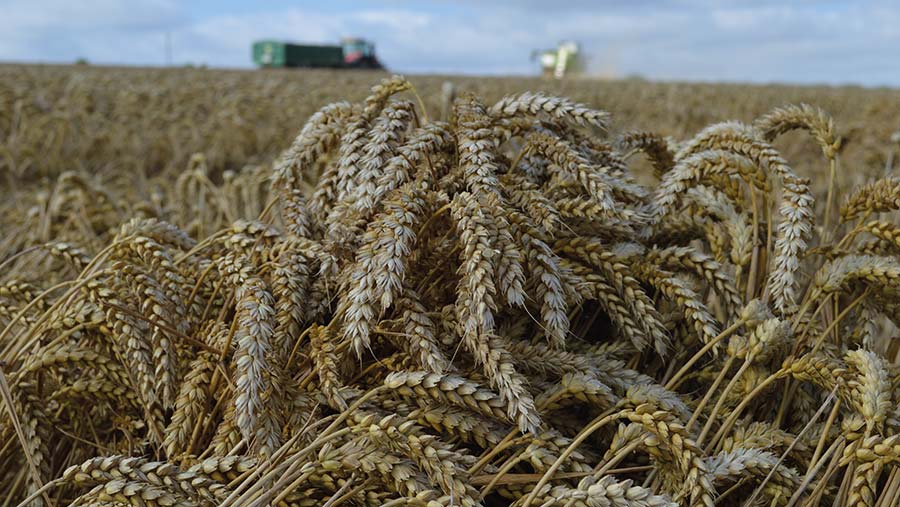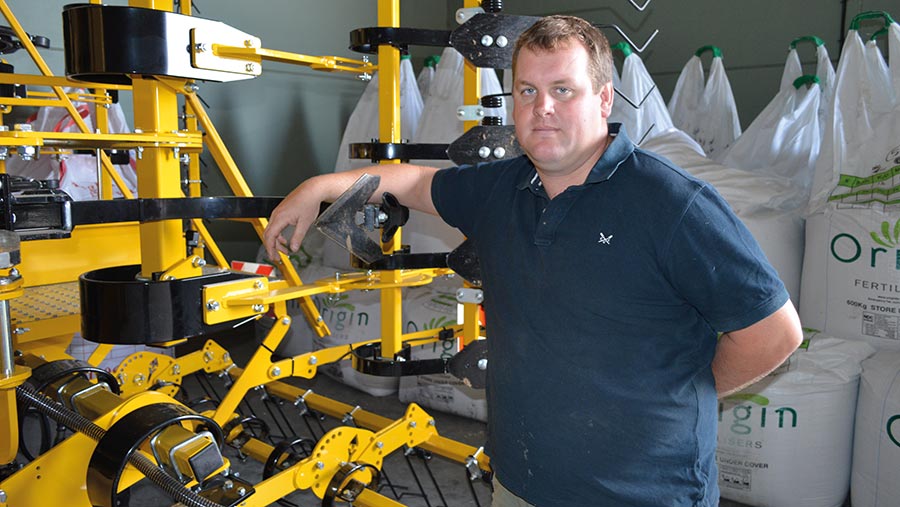Top-yielding new wheat variety is a success on Suffolk farm
 © MAG/David Jones
© MAG/David Jones Henry Ruffle was so impressed with a seed crop of the high-yielding new winter wheat variety Champion that he will be drilling an increased area this month as a commercial crop on his Suffolk family farm.
The feed wheat variety is the top yielder on the AHDB Recommended List and has headed official yield trials this summer with very good resistance to wheat’s most damaging disease – septoria – so has generated good interest among wheat growers.
“We liked the look of it in local trials as the variety looked very even with very big ears, so we were keen to try it on the farm,” he tells Farmers Weekly.
See also: New Group 2 milling wheat proves top yielder for Oxon farm
Three seed crops
Last season, he grew seed crops of Champion, another newcomer Dawsum and also Insitor on the 800ha of medium clay arable land his family farm based at Moat Farm, Barley Tye, between Stowmarket and Ipswich.
Champion wheat compared with other varieties |
||||||
|
Variety |
Champion |
Dawsum |
Typhoon |
Gleam |
Extase |
Theodore |
|
Fungicide-treated yield (%) |
106 |
104 |
102 |
103 |
101 |
98 |
|
Untreated yield (%) |
90 |
92 |
89 |
80 |
93 |
88 |
|
Lodging (no PGR) |
6 |
7 |
7 |
7 |
7 |
6 |
|
Specific weight (kg/hl) |
74.8 |
79.4 |
76.3 |
76.3 |
78.5 |
73.9 |
|
Disease resistance |
||||||
|
Yellow rust |
8 |
9 |
9 |
5 |
8 |
9 |
|
Brown rust |
5 |
7 |
6 |
6 |
7 |
8 |
|
Septoria one-year |
8.0 |
6.1 |
6.9 |
5.5 |
7.3 |
9.0 |
|
Source: AHDB. Note: Numerical ratings are on a 1-9 scale, where high figures show the character to a high degree |
||||||
The 80ha of Champion and 50ha of Dawsum were grown as first wheats after either winter beans or peas, with land min-tilled and then the Champion drilled in late September, and the latter variety following a month later in late October.
The Champion wheat was very vigour in the autumn and was “out of the blocks” quickly, and always looked ahead of the Dawsum, largely due to the earlier drilling date, he adds.
Some 60ha of the variety Insitor were also drilled in late September and it was a bit slower than the Champion, but Mr Ruffle likes the variety as it does well as a second and third wheat over a range of soil types.
All three seed crops were grown for agronomy and grain group Frontier.
Into the spring and the Champion simply “flew away” and certainly needed a plant grow regulator (PRG) regime, with PGRs at the T0 and T1 timings.
Mr Ruffle believes it may need more PGRs in a wet spring, which would encourage even more growth.
Fungicide and plant growth regulator regime for three wheat varieties at John H Ruffle & Son, Suffolk
- T0 Fungicide folpet, PGRs mepiquat chloride + prohexadione calcium (Canopy) and chlormequat
- T1 Fungicides SDHI fluxapyroxad + azole mefentrifluconazole (Revystar), and PGRs Canopy and chlormequat
- T2 Fungicides picolinamide fenpicoxamid + azole prothioconazole (Univoq) and strobilurin pyraclostrobin
- T3 Fungicides azoles prothioconazole + tebuconazole (Prosaro)
Champion and Dawsum had the same treatments, but Insitor had a different T1 of SDHI benzovindiflupyr + azole prothioconazole (Elatus Era), azole tebuconazole and folpet to boost protection from rust diseases.
Low-disease spring
In the dry spring this year there was little sign of disease, and due to the earlier drilling and its slightly earlier maturity, the Champion was always seven to 10 days ahead of the Dawsum throughout the season, and looked very good all the way up to harvest.
All first wheats received 200kg/ha of nitrogen in a three-way split.
Come harvest, the Champion yielded an impressive 11.96t/ha when harvested on 27 July, but the later maturing Dawsum was even higher at just over 13t/ha when cut on 5 August, compared with the farm’s five-year average for wheat at about 11t/ha.
Mr Ruffle says this difference in yield was likely due to the later developing Dawsum, benefiting more from rain on the farm in late June, to help fill the grains of the variety compared with the more mature Champion.
“The Dawsum showed delayed development and was slow to grow away in the spring, but because of the season, this benefited the variety rather than hindered it,” he says.
Specific weight
The greater yield looked to have come from a higher specific weight, with the Dawsum at 84-85kg/hl compared with Champion at 78-79kg/hl, due largely to the weather and Dawsum’s higher genetic specific weight than Champion as demonstrated in the AHDB Recommended List.
The season was generally a good one for specific weights, especially compared with 2021, when a dull June saw Firefly come in at a disappointing 67-68kg/hl on the Suffolk farm.
Mr Ruffle’s commercial wheat crops for harvest 2022 were focused on soft-milling Group 3s such as Elicit, Prince and Firefly.
This coming season, Mr Ruffle is looking to drill 90ha of Champion as a commercial crop on some contracted land a few miles away from the farm, so it will be useful to grow a variety with orange wheat blossom midge resistance so far away from the farm.
He is also drilling 85ha of Dawsum as a commercial crop, with both grown as second wheats.

© MAG/David Jones
This season he has changed drills to a Claydon hybrid, which allows him to strip seed directly into stubble rather than use min-till and drill with a Vaderstad, and the new drill has worked well for the oilseed rape establishment this summer.
He is planning to drill in late September for the Champion and again is looking at a good PGR programme at T0 and T1, and may even use mepiquat chloride + 2-chloroethylphosphonic acid (Terpal) if a wet spring produces lush early growth.
Variety view
Champion is set to find interest from wheat growers looking for top yields and very good septoria resistance, although seed supplies this autumn are tight, with only enough to take 1-2% of the wheat seed market.
“In terms of out-and-out yield and septoria resistance, there is nothing else like it,” says Chris Piggott, seed manager at Frontier.
He adds that the variety is not one to drill very early, but from late September and into October, and has performed well in the eastern region of England.
Its good septoria resistance should appeal to growers in the wetter West, while it has the added advantage of resistance to orange wheat blossom midge.
The variety is fast-developing – both in the autumn and spring – although not as fast as Extase, so that’s why experts advise drilling only from the last week of September onwards.
Its overall maturity to harvest is in line with Skyfall and Gleam.
The hard-milling feed wheat from breeder DSV is the highest yielder on the AHDB Recommended List and is a good performer across a number of sites.
On the downside, it has a lowish specific weight and lacks the straw strength of some of its key rivals.
The variety shows a fungicide-treated yield of 106%, ahead of Dawsum on 104%, and old favourites such as Gleam on 103% and Graham on 102%. I
ts strong disease-resistance package puts it third for untreated fungicide yield at 90%, just behind Extase and Dawsum.
Its strong disease ratings are led by a high 8.0 score for its one-year septoria resistance, third best after Theodore on 9.0 and Mayflower on 8.2, and ahead of Extase on 7.3 and Dawsum on 6.1, in a 1-9 scale where 1 is susceptible and 9 shows good resistance.
Specific weight is on the low side at 74.8kg/hl compared with Dawsum’s 79.4kg/hl and Extase’s 78.5kg/hl, but all are above animal feed compounders’ minimum standard of 72kg/hl.
The variety’s straw strength is a little weaker than its competitors with a 6 rating, with other wheat varieties such as Extase, Graham, Gleam and newcomer Dawsum rated 7s.
Growers are advised to avoid weak straw problems by not drilling too early and using a PGR programme.

